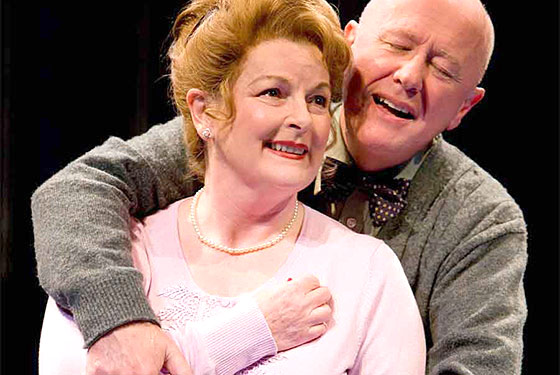
Mr. Jack Berry (Niall Buggy, late of Enda Walsh’s Penelope) is in a state of advanced aesthetic narcosis, showing signs of an incipient Humbertism. Lovestruck by a young, childlike elocution tutor, Hazel (Beth Cooke), he moons, he versifies, he agonizes, and the ache of it all is just exquisite, positively literary. He’s not young or spry, but he’s nevertheless a dreamer, a reader, a hobby gardener, and unemployed — a dangerous combination. “Ever since my wife— ” he breaks off, puddling up. Hazel is charmed, if not quite seduced. Mr. Berry is thrilled, if not quite fulfilled. The game is on. There’s just one small problem. Mrs. Berry isn’t “—.” She’s very much alive, and because she’s played by Brenda Blethyn, she’s about to be very vividly upset — especially when she discovers that Mr. Berry has been slowly giving away her clothes to Hazel while trying to gaslight her into believing she sold them herself. There will be blood! Well: There was on opening night. Blethyn, throwing herself into a particularly physical scene, suffered a visible wound. But then, all of the wounds in Haunted are visible.
This is the premise of Edna O’Brien’s new play, a reservedly absurd domestic memory tempest that creates a nice, safe cage, thickly padded with allusion and philology, for two fiercely talented stage legends to battle it out. O’Brien makes it perfectly clear, from the get-go, that this is an Albeean struggle to the death: Jack and Gladys are, more or less, her Anglo-Irish George and Martha. (There’s a phantom-child involved, and the faintest breath of incest.) O’Brien even nods to The Zoo Story, a little clumsily, to make her intentions plain. She does an awful lot of nodding throughout the play — Hamlet, Othello, Long Day’s Journey Into Night, and William Allingham’s “The Faeries” to name just a few. Mr. Berry loves his tomes — is dissolving in them, really — and sometimes, he (and O’Brien) seem to be overturning an entire bookshelf on the audience. Hazel is Ophelia, Lolita, Electra, Iphigenia; Mr. Berry is Humbert, Prufrock, Claudius, Hamlet. Even Gladys, that gimlet-eyed literalist — a natural breadwinner from a no-nonsense working-class background — gets into the game, picking up Mr. Berry’s Hamlet references and flogging them.
The play is mostly drumroll — near-misses, farcical crisscrosses, a menacing carousel horse suspended from the ceiling — as we wait for a final showdown, flesh against flesh, unmediated by literature. It comes. And then it goes. O’Brien throws a lot of mulch on her play, sometimes nearly smothering it in rhythmic poesy. But beneath this swoon of words, words, words, the play is governed by a cipher. Buggy’s Mr. Berry is an elusive creature, false as foxfire and indistinct, even to himself. His natural state is a kind of besotted-ness, a coping mechanism he seems to have developed after being dispossessed by his patrician mother. (She didn’t approve of Gladys, and so bye-bye family-fortune — though Berry, ill-suited for work, seems to depend on his wife for cash.) The world of his mind, as designed by Simon Higlett and Set-Up, is a fervid greenhouse begrimed with decades of humid fantasy. He’s our Virgil on this descent, but O’Brien seems a little afraid of the monster she’s created here.
Berry likes to quote Othello, yet he’s closer kin to Iago, hopelessly opaque: Buggy knits soft-boiled Britishness into a kind of invisibility cloak, but there’s a bludgeon underneath. Preoccupation, abstractedness, diffidence: They’re weapons in his hands. To extricate himself from his wife’s gross clasps, he claims he has “a growth,” when, in fact, he has the opposite: He’s regressing, and his Hazel-crush is all bound up in romantic nostalgia, aching memories of the “first blush” with Gladys — and an early trauma that killed their future happiness in the shell. Berry’s cruelties and lies are like reflexes, not conspiracies; his motives are incalculable, primordial, evasive — male, in other words, or so this show would have it. Blethyn, as Gladys, throws herself tidally against him again and again, and the effect is positively oceanic: spectacular, but maybe a little repetitive. Finally, the play simply subsides (with some epilogic fuss that verges on judgment and bathos).
Haunted mates two dazzlingly great performers and gets under your skin, but it stops well short of the full Albeean purge. O’Brien clearly doesn’t believe that’s possible: Like “Rappachini’s Daughter,” the poison is worked in too deep — this play’s life force is deadly nightshade. In the end, it drifts on a sea of oblivion and regret. O’Brien and her stop-and-go director, Braham Murray, hint at the inherent violence of garden-variety marital detachment — a subject rarely treated on the American stage, and never with complete honesty — but somewhere in the weeds, amid all those allusive blooms and all that heady floral imagery, the shears grow ever so slightly dull. Which, luckily, doesn’t stop Buggy and Blethyn from using them as blunt instruments.
Haunted, at 59E59 Theaters through January 2




